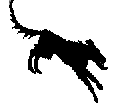SHUCKLAND  |
|||||||||||||||||||||||||||||||||||||||||||||||||||||||||||||||||||||||||||||||||||||||||||||||||||||||||||||||||||||||||||||||||||
|
|
Analysing
the Hell out of the Beast
Part Two: Size and Eyes Although the mythology says that Shuck is always enormous (often 'the size of a calf'), let's see if that is borne out by the stories. Of the 84 legends collected here, only 29 (34.5%) even mention size at all, which is surprising. The descriptions range from the fairly normal 'large' or 'big', through 'huge' and 'enormous', to 'calf-sized', 'donkey-sized', and 'sometimes as big as a bullock.' With the encounters, 60.1% mention the size, with a similar kind of range.
The split is very nearly even, which somewhat blunts the statement in Janet and Colin Bord's 1987 book 'Modern Mysteries of Britain' that paracanines are "always large, bigger than the biggest dog and often described as calf-sized." Of those giving an 'unnatural' size, only 2 of the legends state that the dog is 'calf-sized', and only 14 of the encounters. Of those 14, only 4 have occurred since the 1940's - and that's probably because not many people nowadays have much of a notion of exactly how big a calf is! Being a townie myself (though on the edge of the countryside), and not having been anywhere near cows since I was a kid, I certainly have no idea! And what age of calf? Newly-born? Six months old? Just when does a calf stop being a calf and become a cow? These questions might seem mundane, but an awful lot of the descriptions of size depend on the witness's perceptions. Without a definition of 'large', 'big' or 'huge' from the witness's point of view, such descriptions are relatively meaningless. One witness described the dog they saw as "large, about 2 1/2 feet tall." Another said that their paracanine was "large, the size of a Great Dane." Two very different meanings of the term 'large.' Great Danes, St. Bernards and
Irish Wolfhounds regularly exceed 36" (91cm) in height at the
shoulder, so it's quite possible that, barring any other paranormal
characteristics, what a witness has seen is a perfectly normal dog. (The
tallest dog ever recorded, a Great Dane, stood 44" (112cm) at the
shoulder, so we can be fairly sure that any dog bigger than that is just
a bit out of the ordinary!) Now to the eyes. Those saucer-sized, fiery, glowing eyes, that strike fear into the witness's heart. I was startled to find that only 20 (23.8%) of the legends mention eyes at all. And only 32 (17.4%) of the encounters. Not very much upon which to build a substantial part of the mythology of Shuck. The single Cyclopean eye only turns up once in the legends of East Anglia, and three times in actual encounters. Below is a broad breakdown (note that different descriptions may apply to the same eyes), followed by a more detailed breakdown of the precise eye description:
In the encounters, the 2 examples of 'saucer eyes' come from the 1910's and 1970's. The eyes 'blazing', 'fiery' or 'like coals' are spread from the early 1800's to the late 20th century, while those 'shining', 'glowing' or 'like lamps' are confined to pre-1940, apart from four, in 1982, 1995, 1996 and the early 2000's. Those described as 'gleaming', 'glaring' or 'yellow' could well be the result of light reflecting back from the dog's eyes in a perfectly normal manner. |
||||||||||||||||||||||||||||||||||||||||||||||||||||||||||||||||||||||||||||||||||||||||||||||||||||||||||||||||||||||||||||||||||
